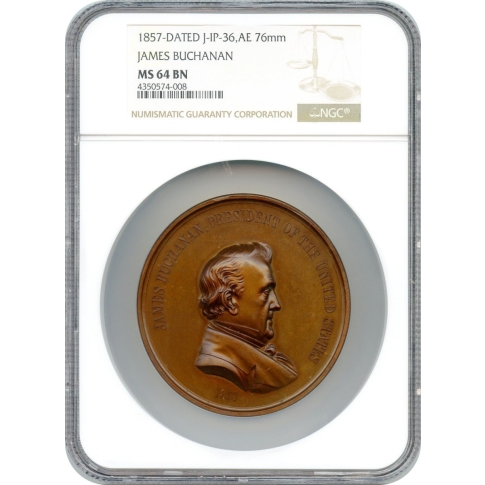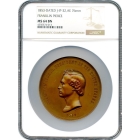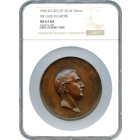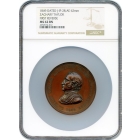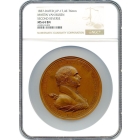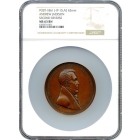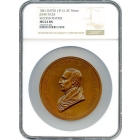Indian Peace Medal - 1857 James Buchanan, J-IP-36 AE 76mm NGC MS64
Peace Medals were instrumental in building relationships with the various Indian Tribes. American Presidents (and their Colonial predecessors) used Indian Peace Medals as a way of placating various tribes and/or to build alliances with them. The recipients valued them highly, for they conferred a prestige that was recognized throughout the nation. The Bureau of Indian Affairs considered them crucial and the Presidents for whom they were issued also knew their importance. Many images from the "Old West" show Indians proudly wearing their Peace Medals (sometimes more than one). Generally, bronze medals were not used for presentation purposes, but in some cases, they were silver-plated and either given, sold, or traded away by unscrupulous individuals to unwitting recipients.
NGC total census of 6 medals. 2 are in this Very Choice Brilliant Uncirculated grade with 1 finer (MS65 is finest at this time).
James Buchanan Indian Peace Medals
Shortly after the inauguration of James Buchanan, Random H. Gillet began to use his political clout on behalf of artists Joseph Willson and Salathiel Ellis, who worked on the Fillmore medals (and Ellis alone did the Pierce medals). On March 9, 1857, he wrote to the new Secretary of the Interior, Jacob Thompson, about Willson: "...I shall consider myself much your debtor, if you will direct the Commissioner of Indian Affairs to award [the work of creating the Buchanan medal] to him." In response to Gillet's letter, Thompson brought the matter up with the Indian Office. When Gillet learned that Charles E. Mix, the Indian Affairs Commissioner, was to discuss it with the president directly, he wrote to Buchanan on behalf of Willson. Another artist, Anthony C. Paquet, sought the medal commission, with Pennsylvania Congressman Thomas B. Florence as his sponsor. But he would have to wait, because the Indian Office gave the job to Willson and Ellis.
It was around the end of August that the artists said the dies were "well advanced," and they asked for any available old medals as well as money to buy more silver. Mix did not want to advance any funds until a formal contract was drawn up, covered by a bond. Willson and Ellis were to be paid $2,400 for crafting four dies: two with the right-facing bust of Buchanan, and two with "the new devise adopted by the Commissioner of Indian Affairs," as well as producing 52 of the large medals weighing at least 5 ounces each and 70 smaller medals. Unfortunately, Joseph Willson passed away suddenly on September 8, 1857, and Ellis finished the work on his own. There was a delay in getting approval of the designs.
The reverse design by Willson presented an ambitious design: within a round medallion in the center of the medal is a church, house, and children playing while an Indian was plowing. Between the medallion and the rim is an Indian scalping another Indian. Below is the head of an Indian woman, a bow, quiver of arrows, and peace pipe. The message is quite clear, promoting the peaceful, productive culture over that of the savage Indians. However, there was one sticking point: the Indian manning the plow was wearing an Indian headdress, and the President and Secretary of War wanted it removed. But the dies were too far along, and no changes could be made.
James Buchanan and the Indians
There was virtually no uniform Indian policy in place when James Buchanan took office in 1857. The Union was on the brink of Civil War, and the federal government had no time for maintaining Indian policy. Therefore the "Indian system" was left in the hands of greedy and dishonest Indian agents who mostly got their jobs as political appointees. The only Indian policy Buchanan had was that he felt they needed to be kept on reservations. "As settlers moved further west, the idea of assimilating Indians disappeared," writes Jean Baker, history professor at Goucher College and author of a 2004 biography of Buchanan. "The treaty was the new vehicle, and this modern construct of sticking the Indians on pieces of land and giving them a little food was the policy that Buchanan supported."
Buchanan was overwhelmed by civil war on the horizon, and ignored the Indians, whose situation grew more desperate each year. Traders who had rights to do business with them cheated them constantly, and the Senate purchased land from starving Indians and then gave it to white settlers. Likewise, state and territorial governments also took great advantage of the Indians, and hauled in the army for support when needed. "Settlers were still moving across the West, so Buchanan supported the construction of forts to protect them," writes Jean Baker. "Buchanan was a huge expansionist. He supported taking over huge swaths of land and justified this in the way his generation of policymakers did. He believed in the superiority of the white man, and that the white men used the land in a better way than the Indians did."
April 1858 saw the Yankton Sioux give up eleven million acres of land in South Dakota. Chief Struck-by-the-Ree was among the signators. He warned his people: "The white men are coming in like maggots. It is useless to resist them...we could not hope to stop them. Many of our brave warriors would be killed, our women and children left in sorrow, and still we would not stop them. We must accept it, get the best terms we can and try to adopt their ways."
James Buchanan Indian Peace Medals for Indians and Collectors
Dated 1859, the silver medals were available in 76 mm and 62 mm sizes. Again, this medal was privately struck in New York City. R.W. Julian writes, "No medal of this type has been seen or noted in bronze. It is listed purely on the supposition that it does exist."
| Grading Service | NGC |
|---|---|
| Year of Issue | 1857 |
| Grade | MS64 |
| Denom Type | U.S. Mint Medal |
| Numeric Denomination | Medal |
| Mint Location | Philadelphia |
| Designation | NONE |
| Circ/UnCirc | Uncirculated |
| Strike Type | Business |
| Holder Variety | James Buchanan: J-IP-36, AE, 76mm |
| Grade Add On | NONE |
| Holder Type | N/A |

